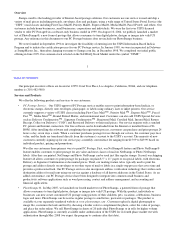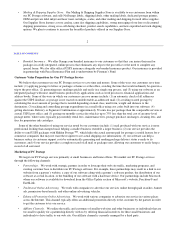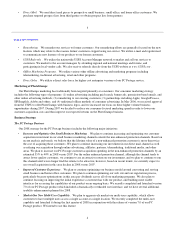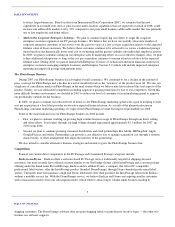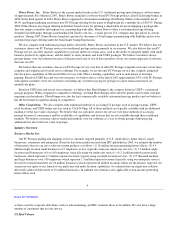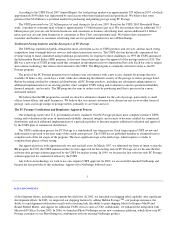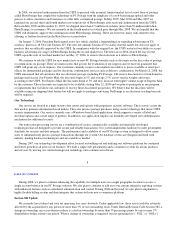Stamps.com 2007 Annual Report Download - page 14
Download and view the complete annual report
Please find page 14 of the 2007 Stamps.com annual report below. You can navigate through the pages in the report by either clicking on the pages listed below, or by using the keyword search tool below to find specific information within the annual report.
If we fail to meet the demands of our customers, our business will be substantially harmed and could fail.
Our services and products must meet the commercial demands of our customers, which include home businesses, small
businesses, corporations and individuals. We cannot be sure that our services will appeal to or be adopted by an ever-growing
range of customers. If we are unable to ship products such as items from our Supplies Store or PhotoStamps in a timely manner
to our customers, our business may be harmed. Moreover, our ability to obtain and retain customers depends, in part, on our
customer service capabilities. If we are unable at any time to address customer service issues adequately or to provide a
satisfactory customer experience for current or potential customers, our business and reputation may be harmed. If we fail to
meet the demands of our customers our results of operations will be adversely affected.
A failure to further develop and upgrade our services and products could adversely affect our business.
Any delays or failures in developing our services and products, including upgrades of current services and products, may
have a harmful impact on our results of operations. The need to extend our core technologies into new features and services and
to anticipate or respond to technological changes could affect our ability to develop these services and features. Delays in
features or upgrade introductions could cause a decline in our revenue, earnings or stock price. We cannot determine the ultimate
effect these delays or the introduction of new features or upgrades will have on our revenue or results of operations.
Increases in payment processing fees would increase our operating expenses and adversely affect our results of operations.
Our customers pay for our services predominately using credit cards and debit cards and, to a lesser extent, by use of
automated clearing house (“ACH”). Our acceptance of these payment methods requires our
11
TABLE OF CONTENTS
payment of certain fees. From time to time, these fees may increase, either as a result of rate changes by the payment processing
companies or as a result in a change in our business practices which increase the fees on a cost-per-transaction basis. If these fees
for accepting payment methods increase in future periods, it may adversely affect our results of operations.
A decline in our ability to effectively bill our customers by credit card and debit card would adversely affect our results of
operations.
Our ability to effectively charge our customers through credit cards and debit cards is subject to many variables, including
our own billing technology and practices, the practices and rules of payment processing companies, and the practices and rules
of issuing financial institutions. If we do not effectively charge and bill our customers in future periods through credit cards and
debit cards, it would adversely affect our results of operations.
Third party assertions of violations of their intellectual property rights could adversely affect our business.
Substantial litigation regarding intellectual property rights exists in our industry. Third parties may currently have, or may
eventually be issued, patents upon which our products or technology infringe. Any of these third parties might make a claim of
infringement against us. We may become aware of, or we may increasingly receive correspondence claiming, potential
infringement of other parties’ intellectual property rights. We could incur significant costs and diversion of management time
and resources to defend claims against us regardless of their validity. Any associated costs and distractions could have a material
adverse effect on our business, financial condition and results of operations. In addition, litigation in which we are accused of
infringement might cause product development delays, require us to develop non-infringing technology or require us to enter
into royalty or license agreements, which might not be available on acceptable terms, or at all. If a successful claim of
infringement were made against us and we could not develop non-infringing technology or license the infringed or similar
technology on a timely and cost-effective basis, our business could be significantly harmed or fail. Any loss resulting from
intellectual property litigation could severely limit our operations, cause us to pay license fees, or prevent us from doing
business.
A failure to protect our own intellectual property could harm our competitive position.
We rely on a combination of patent, trade secret, copyright and trademark laws and contractual restrictions, such as
confidentiality agreements and licenses, to establish and protect our rights in our products, services, know-how and information.
We have a portfolio of issued and pending US and international patents. We also have a number of registered and unregistered
trademarks. We plan to apply for more patents in the future. We may not receive patents for any of our patent applications. Even
if patents are issued to us, claims issued in these patents may not protect our technology. In addition, a court might hold any of



